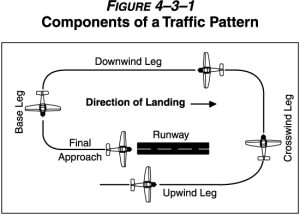Takeoff and climb out is not the upwind. Yup, I know lots of people call the “upwind” in the traffic pattern as they climb after takeoff, but they are actually calling “upwind” in the wrong spot. And being accurate when you tell people where you are in the traffic pattern can be important. I’ll admit, this is something of a pet peeve of mine, but let’s all learn from it.
So what exactly is an upwind you might ask if it isn’t when you are climbing out after takeoff?
Well, according to the AIM (4-3-1), an upwind is “a flight path parallel to the landing runway in the direction of landing.” It is not the takeoff or climb out (which is actually not labeled in the AIM). What is the importance of the distinction you may ask? Well, it’s about whether you can be expected to be parallel to the runway flying in the direction of a takeoff, but at a pattern altitude, or whether you have just taken off and will be climbing in line with the runway to traffic pattern altitude.
Both a takeoff or climb out and an upwind may be followed by entry to the crosswind if a pattern is to be flown.
So why would someone fly an upwind?
Typically an upwind is used to enter the traffic pattern when approaching the airport from the opposite side from the normal traffic pattern side or for faster aircraft using the additional time in a traffic pattern to slow down and/or setup for landing. For example, and take a moment to visualize this, imagine a 9-27 runway with an active left hand traffic pattern for runway 9. This would put the active side of the pattern on the north side of the runway. An aircraft approaching from the south could choose to enter the traffic pattern on the upwind, fly parallel to runway 9, turn crosswind at the end, then turn left again to enter the downwind. This could offer the pilot more time to slow down, set up configurations, or just get ready for landing than it might if the pilot instead entered a “mid-field left-downwind.”
While this may not be as critical in slower aircraft, in higher performance aircraft, aircraft with retractable gear, or aircraft that need to descend from turbine pattern altitudes (remember these are typically 1500′ AGL instead of 1000′ AGL) this can be valuable extra time that keeps a pilot from being rushed.
For pilots sharing the pattern, it means that they should actually be looking for aircraft who have reported the “upwind” to be flying a parallel line to the runway, not on the takeoff/climb out portion of a traffic pattern.
So if you didn’t before, now you know. Next time you are taking off and climbing out and need to make a traffic pattern call, report takeoff or climb out if that’s what you are doing instead of calling the “upwind.” And if you hear someone else reporting the “upwind,” you now know where you should be looking for them (assuming they know what you know about what an upwind really is).
Jason Blair is an active single and multi-engine instructor and FAA Designated Pilot Examiner with 4,800 hours total time and 2,700 hours instruction given. He has served on several FAA/Industry aviation committees and has and continues to work with aviation associations on flight training issues. He also consults on aviation training and regulatory efforts for the general aviation industry.





